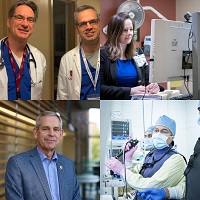The Department of Medicine (DOM) is the largest Department within the Faculty of Health Sciences at Queen’s University and incorporates the disciplines of internal medicine specialties and subspecialties. The DOM works very closely with SEAMO and has been a member of SEAMO since its inception in 1994. The DOM accounts for ~ 20% of the faculty in the Medical School, ~ 40% of inpatient care. The Department of Medicine has over 130 faculty members and is comprised of 14 divisions:
Queen’s University and incorporates the disciplines of internal medicine specialties and subspecialties. The DOM works very closely with SEAMO and has been a member of SEAMO since its inception in 1994. The DOM accounts for ~ 20% of the faculty in the Medical School, ~ 40% of inpatient care. The Department of Medicine has over 130 faculty members and is comprised of 14 divisions:
- Allergy and Immunology
- Cardiology
- Dermatology
- Endocrinology and Metabolism
- Gastroenterology
- General Internal Medicine
- Geriatric Medicine
- Hematology
- Infectious Diseases
- Nephrology
- Neurology
- Palliative Medicine
- Respirology and Sleep Medicine
- Rheumatology
Dr. Stephen Archer, Department Head, said the increase in faculty from 60 in 2012 to the current 132 was necessary for several reasons. “We needed more faculty to be able to provide better care for our patients, provide better education for our learners and to perform better research for the world. We intended to shorten wait times, create clinical programs of distinction and enable increased disease specialization, reflecting the modern practice of Medicine,” he said. “The growth in size of the Department has also been essential to support the creation of new Divisions, like Dermatology; new training programs, like Endocrinology; and to deal with an evolution in the workforce, which accounts for maternity and parental leaves and supports physician wellness.” DOM faculty members are also required to manage 11 PGME programs with over 125 trainees, numerous outpatient clinics, 180-200 inpatient beds at Kingston Health Sciences Centre each day, as well as 33 geriatric beds and a palliative care unit at Providence Care Hospital. Many members of the DOM are highly engaged in research and have clinician-scientist role descriptions. The current annual budget for DOM research is ~9 million. The DOM has also created a new promotion track in Health Quality and has ~10 faculty pursuing academic excellence in this domain.
It would transpire that in 2020, with the COVID-19 pandemic, the Department would never be busier and never more in need of its talented faculty. Dr. Archer said the Department has always invested in their people, by supporting and acknowledging their professional development and their accomplishments. “We did this in order to retain the best and the brightest and to elevate our team members. Tangible investments include the creation of a Women in Medicine program; a mini-sabbatical program; a program of citizenship, which gives time allowances for participation in the life of the Department; a mentorship program; a benefits program including maternity and parental leave; and an awards program, which acknowledges faculty success in all domains.” Dr. Archer also noted that with such a large Department, the only way to run it successfully was to build a well-respected, effective senior executive team. Under the able management of Ms. Anita Ng, this team includes our Deputy Head of Medicine, Dr. Chris Smith, our talented Division Chairs, our leads in clinical care, medical education, research, translational medicine, and equity, diversity and inclusiveness.
The DOM is home to the Queen’s Cardiopulmonary Unit (QCPU), a $10 million, CFI-funded translation research center with 4 scientists and state-of-the-art equipment that support basic and translational research for over 60 researchers from three faculties. The DOM is also home to the Translational Institute of Medicine (TIME): a virtual institute comprised of over 200 basic and clinician scientists. It was created to capture the breadth of translational research at Queen’s and maximize the sharing of state-of-the-art research platforms and expertise between research groups in the DOM and their collaborators. The Department also offers an amazing and unique graduate program in Translational Medicine (TMED). The TMED program aims to train the next generation of researchers to be effective bidirectional translators of fundamental biomedical science to improve human health. The TMED graduate program is currently in its third year and offers both a MSc and PhD track. Both QCPU, TIME and TMED are innovations which have been created through the efforts of the DOM and its faculty, who have also largely funded these enterprises.
Dr. Archer is proud that the Department has built a faculty of resilient, adaptable, collegial and cohesive members that have worked hard during the pandemic. “We did not build our robust research platforms in anticipation of fighting a virus; but our long commitment to fostering research and to the development of clinician scientists, combined with new research infrastructure and connectivity platforms, have enabled our researchers to pivot quickly and tackle COVID-19 research head on.” The DOM has also shifted towards virtual health care during COVID-19. “Our progressive and proactive thinking on offering eHealth and telehealth access to care was not done in anticipation of a virus that would prevent patients from coming to clinics. Rather, it was done with the view that patients’ time was valuable and in recognition that clinic space would always be in short supply. As it turns out, being ‘ahead of the game’ in virtual care allowed us to take a lead throughout the pandemic as we sought to provide care in alternate ways.”
“What can I say about the DOM to conclude? It is a collegium of remarkable colleagues with whom I am privileged to work,” said Archer.
For more information, visit their website.
